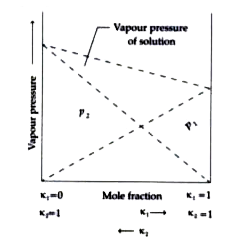For Dalton's law of partial pressure derive the expression
Pgas=Xgas⋅Ptotal.
To derive the expression for Dalton's Law of Partial Pressure, which states that the pressure of a gas (P_gas) is equal to its mole fraction (X_gas) multiplied by the total pressure (P_total), we can follow these steps:
Step 1: Understand the System
Assume we have a container that holds three different gases: A, B, and C. Let:
- V = volume of the container
- T = temperature of the gases
- P_total = total pressure exerted by the mixture of gases in the container
Hint: Visualize the container and the gases inside it to understand how they interact.
Step 2: Write the Total Pressure Equation
According to Dalton's Law, the total pressure in the container is the sum of the partial pressures of each gas:
Ptotal=PA+PB+PC
Hint: Remember that partial pressure is the pressure that each gas would exert if it occupied the entire volume alone.
Step 3: Use the Ideal Gas Law
The ideal gas law states:
P=nRTV
Where:
- P = pressure
- n = number of moles of gas
- R = ideal gas constant
- T = temperature
- V = volume
For each gas, we can express the partial pressures:
- For gas A:
PA=nARTV
- For gas B:
PB=nBRTV
- For gas C:
PC=nCRTV
Hint: Recognize that R and T are constants for the system, and V is also constant.
Step 4: Substitute Partial Pressures into Total Pressure
Substituting the expressions for PA, PB, and PC into the total pressure equation:
Ptotal=nARTV+nBRTV+nCRTV
Hint: Factor out the common terms to simplify the equation.
Step 5: Factor Out Common Terms
Factoring out RTV:
Ptotal=RTV(nA+nB+nC)
Hint: This shows that total pressure is directly related to the total number of moles of gas.
Step 6: Define Mole Fraction
The mole fraction XA of gas A is defined as:
XA=nAnA+nB+nC
Hint: This is a crucial definition that will help relate partial pressure to total pressure.
Step 7: Relate Partial Pressure to Total Pressure
Now, we can express the partial pressure of gas A in terms of the total pressure:
From the equation of PA:
PA=nARTV
And from the total pressure:
Ptotal=RTV(nA+nB+nC)
Dividing PA by Ptotal:
PAPtotal=nARTVRTV(nA+nB+nC)
Hint: Notice how the RT/V terms cancel out.
Step 8: Simplify the Expression
This simplifies to:
PAPtotal=nAnA+nB+nC
Thus, we can express PA as:
PA=XA⋅Ptotal
Hint: This is the final relationship we wanted to derive.
Conclusion
We have derived the expression for Dalton's Law of Partial Pressure:
Pgas=Xgas⋅Ptotal
Hint: This shows that the partial pressure of a gas is directly proportional to its mole fraction in the mixture.
Assume we have a container that holds three different gases: A, B, and C. Let:
- V = volume of the container
- T = temperature of the gases
- P_total = total pressure exerted by the mixture of gases in the container
According to Dalton's Law, the total pressure in the container is the sum of the partial pressures of each gas:
Ptotal=PA+PB+PC
The ideal gas law states:
P=nRTV
Where:
- P = pressure
- n = number of moles of gas
- R = ideal gas constant
- T = temperature
- V = volume
- For gas A:
PA=nARTV
- For gas B:
PB=nBRTV
- For gas C:
PC=nCRTV
Substituting the expressions for PA, PB, and PC into the total pressure equation:
Ptotal=nARTV+nBRTV+nCRTV
Factoring out RTV:
Ptotal=RTV(nA+nB+nC)
The mole fraction XA of gas A is defined as:
XA=nAnA+nB+nC
Now, we can express the partial pressure of gas A in terms of the total pressure:
From the equation of PA:
PA=nARTV
And from the total pressure:
Ptotal=RTV(nA+nB+nC)
PAPtotal=nARTVRTV(nA+nB+nC)
This simplifies to:
PAPtotal=nAnA+nB+nC
Thus, we can express PA as:
PA=XA⋅Ptotal
We have derived the expression for Dalton's Law of Partial Pressure:
Pgas=Xgas⋅Ptotal
Topper's Solved these Questions
- BOOK - CBSE COMPLEMENTARY MATERIALCHAPTER - STATES OF MATTER : GASES, LIQUIDS AND SOLIDSEXERCISE - HOTS QUESTIONS4videos
STATES OF MATTER : GASES, LIQUIDS AND SOLIDS
- BOOK - CBSE COMPLEMENTARY MATERIALCHAPTER - STATES OF MATTER : GASES, LIQUIDS AND SOLIDSEXERCISE - 3-MARK QUESTIONS10videos
STATES OF MATTER : GASES, LIQUIDS AND SOLIDS
- BOOK - CBSE COMPLEMENTARY MATERIALCHAPTER - SOME BASIC CONCEPTS OF CHEMISTRY EXERCISE - UNIT TEST12videos
SOME BASIC CONCEPTS OF CHEMISTRY
- BOOK - CBSE COMPLEMENTARY MATERIALCHAPTER - STRUCTURE OF ATOMEXERCISE - UNIT TEST8videos
STRUCTURE OF ATOM
Similar Questions
Knowledge Check
- Question 1 - Select One
Dalton's law of partial pressure are applicable to
ANon-reacting gasesBIdeal gasesCTemperature of the component gases in the mixtureDAll of the above - Question 2 - Select One
Dalton's law of partial pressures is not applicable to
AMixture of H2 and N2BMixture of H2 and Cl2CMixture of H2 and CO2DNone - Question 3 - Select One
Dalton's law of partial pressures cannot hold good for
ANO2+O2BH2+Cl2CCO2+O2DNH3+He
Dalton's Law of Partial Pressure & Aqueous tension
View SolutionIs Dalton's law of partial pressures valid for a mixture of SO2 and O2?
View SolutionWhat is partial pressure of a gas?
View SolutionRevision|Dalton's Law Of Partial Pressure|Summary
View SolutionRead the passage given below and answer the following questions :
Raoult's law states that for a solution of volatile liquids, the partial vapour pressure of each component of the solution is directly proportional to its mole fraction present in solution. Dalton's law of partial pressure states that the total pressure Ptotal over the solution phase in the container will be the sum of the partial pressures of the components of the solution and is given as:
Ptotal= P1+ P2

A solution of two liquids boils at a temperature more than the boiling point of either of them. What type of deviation will be shown by the solution formed in terms of Raoult' s law ?View Solution

